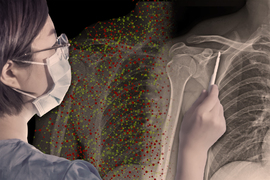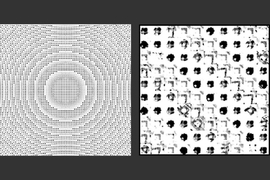In fields such as physics and engineering, partial differential equations (PDEs) are used to model complex physical processes to generate insight into how some of the most complicated physical and natural systems in the world function.
To solve these difficult equations, researchers use high-fidelity numerical solvers, which can be very time-consuming and computationally expensive to run. The current simplified alternative, data-driven surrogate models, compute the goal property of a solution to PDEs rather than the whole solution. Those are trained on a set of data that has been generated by the high-fidelity solver, to predict the output of the PDEs for new inputs. This is data-intensive and expensive because complex physical systems require a large number of simulations to generate enough data.
In a new paper, “Physics-enhanced deep surrogates for partial differential equations,” published in December in Nature Machine Intelligence, a new method is proposed for developing data-driven surrogate models for complex physical systems in such fields as mechanics, optics, thermal transport, fluid dynamics, physical chemistry, and climate models.
The paper was authored by MIT’s professor of applied mathematics Steven G. Johnson along with Payel Das and Youssef Mroueh of the MIT-IBM Watson AI Lab and IBM Research; Chris Rackauckas of Julia Lab; and Raphaël Pestourie, a former MIT postdoc who is now at Georgia Tech. The authors call their method "physics-enhanced deep surrogate" (PEDS), which combines a low-fidelity, explainable physics simulator with a neural network generator. The neural network generator is trained end-to-end to match the output of the high-fidelity numerical solver.
“My aspiration is to replace the inefficient process of trial and error with systematic, computer-aided simulation and optimization,” says Pestourie. “Recent breakthroughs in AI like the large language model of ChatGPT rely on hundreds of billions of parameters and require vast amounts of resources to train and evaluate. In contrast, PEDS is affordable to all because it is incredibly efficient in computing resources and has a very low barrier in terms of infrastructure needed to use it.”
In the article, they show that PEDS surrogates can be up to three times more accurate than an ensemble of feedforward neural networks with limited data (approximately 1,000 training points), and reduce the training data needed by at least a factor of 100 to achieve a target error of 5 percent. Developed using the MIT-designed Julia programming language, this scientific machine-learning method is thus efficient in both computing and data.
The authors also report that PEDS provides a general, data-driven strategy to bridge the gap between a vast array of simplified physical models with corresponding brute-force numerical solvers modeling complex systems. This technique offers accuracy, speed, data efficiency, and physical insights into the process.
Says Pestourie, “Since the 2000s, as computing capabilities improved, the trend of scientific models has been to increase the number of parameters to fit the data better, sometimes at the cost of a lower predictive accuracy. PEDS does the opposite by choosing its parameters smartly. It leverages the technology of automatic differentiation to train a neural network that makes a model with few parameters accurate.”
“The main challenge that prevents surrogate models from being used more widely in engineering is the curse of dimensionality — the fact that the needed data to train a model increases exponentially with the number of model variables,” says Pestourie. “PEDS reduces this curse by incorporating information from the data and from the field knowledge in the form of a low-fidelity model solver.”
The researchers say that PEDS has the potential to revive a whole body of the pre-2000 literature dedicated to minimal models — intuitive models that PEDS could make more accurate while also being predictive for surrogate model applications.
"The application of the PEDS framework is beyond what we showed in this study,” says Das. “Complex physical systems governed by PDEs are ubiquitous, from climate modeling to seismic modeling and beyond. Our physics-inspired fast and explainable surrogate models will be of great use in those applications, and play a complementary role to other emerging techniques, like foundation models."
The research was supported by the MIT-IBM Watson AI Lab and the U.S. Army Research Office through the Institute for Soldier Nanotechnologies.











